Quince is an interesting fruit. It’s hard and dry and astringent when raw, but floral and delicate if cooked. If you put your nose into a bag full of ripe quince, the perfume of the fruit shows its promise.
Quince paste (often called by it’s Spanish name, dulce de membrillo) is a popular spread in Portugal, Italy and Spain. It’s a traditional accompaniment to Manchego cheese, and is spread on bread for a simple breakfast or used in baked treats.
Quince paste is easy to make – it’s a lot like making apple butter – but it takes patient stirring for quite awhile. Here’s how I make mine.
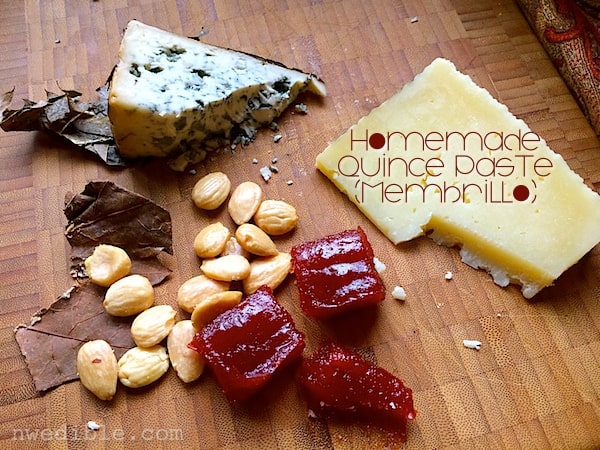
If you don’t have a quince tree, and sadly I do not, you’ll have to buy some quince. The only quince at my market were a touch past firm-ripe. See those brown spots? Ideally I’d like less of those, but my membrillo turned out fine.
This variety is called Pineapple Quince, and is a common commercial type, inasmuch as there is a commercial market for quince in the U.S. at all. Fully ripe, it has a deep, floral, tropical fruit smell that’s beyond delicious. I spent a good 20 minutes just huffing the fruit before I proceeded with this recipe.
Quince are similar in form to their relatives apples and pears. To start, peel and core the quince, and rough chop the fruit into big chunks.

Cover the quince chunks with water and simmer until tender. The quince will turn color – this is one of the amazing things about quince. They are like the mood-rings of the fruit world, with a color that changes from pale yellow to coral to ruby to deep, fire-brick red as they continue to cook.
Strain out the tender quince chunks from the cooking liquid and weigh. Make a note of how much cooked quince you have.
Puree the cooked quince in a food processor until perfectly smooth. Return the quince puree to the empty stockpot. Measure out a weight of sugar equal to your cooked quince and add this to the stockpot with the juice of one lemon for each pound of cooked quince. So, if you have 3 pounds cooked quince, combine this with 3 pounds sugar and the juice of 3 lemons.
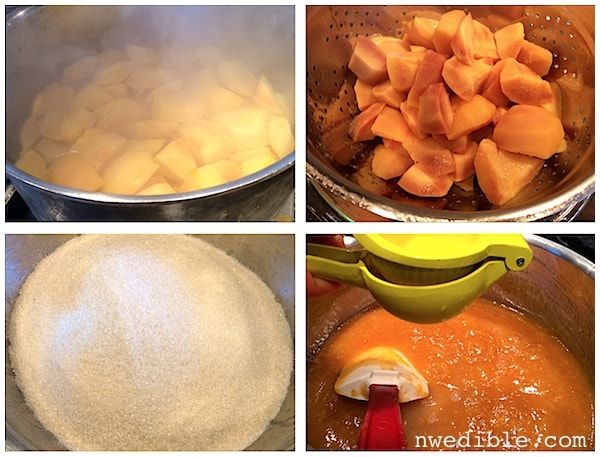
Over medium heat, bring the quince puree to a simmer. Stir periodically and reduce the puree until very thick. Adjust temperature as necessary and stir as needed so puree does not scorch or stick as it reduces.
This will take some time – plan on setting aside a few hours when you’re going to be in and out of the kitchen anyway. I made quince paste concurrently with my Caramelized Onions. I figured as long as I was babysitting one long-cooking item, I could babysit two.
Eventually the puree will reduce to a very thick, dark red paste. When you run a spoon or spatula through the puree it will hold a line.
Scrape the paste into a parchment-lined 9×12-inch pan and smooth the top as best you can. Let the quince paste cool to room temperature, then transfer the uncovered pan to the refrigerator. Chill overnight.
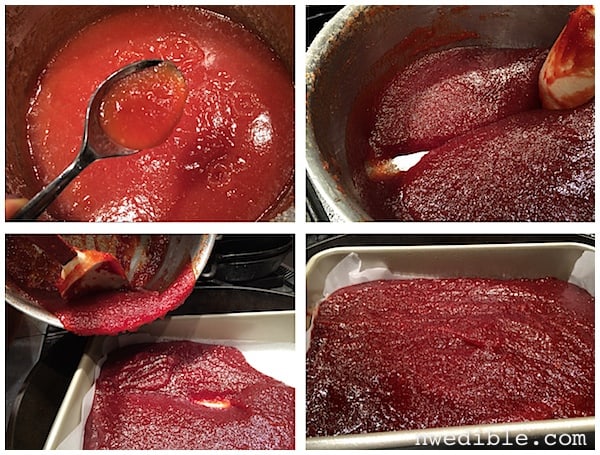
After setting up, the quince paste should hold its shape. To serve, cut as much as you like into bite-sized squares or slices with a sharp knife. Running your knife under very hot water and then drying the blade before slicing can help if your knife sticks badly.
Wrap whatever you don’t use well in parchment, then in plastic wrap. It will keep in the fridge for a long time – several months, at least – because of the very high sugar content.

I like a thin spread of quince paste served alongside Spanish cheeses.
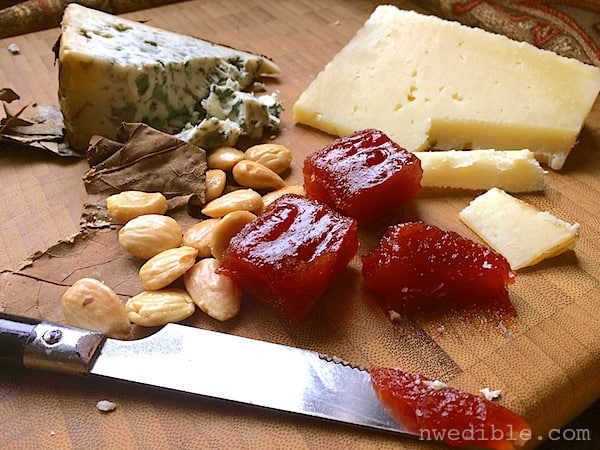
Printable Recipe
Quince Paste (Membrillo)
Ingredients
- 4 pounds quince
- about 3 pounds sugar
- 3 lemons
Instructions
- Peel and core quinces and cut into large chunks.
- Put quinces into a large stockpot and just cover with water. Bring water to a simmer and cook, covered, until quinces are fully tender, about 30 minutes.
- Drain quinces, reserving cooking liquid for another purpose if desired. The quince cooking liquid is flavoful and high in pectin.
- Weigh drained quince pieces. You should have about 3 pounds quince.
- Transfer quinces to a food processor and puree until totally smooth.
- Return quince puree to the empty stockpot and add as much sugar by weight as you have quince puree. If you have more or less quince puree, adjust your sugar quantity accordingly.
- Add the juice of three lemons (or one lemon per each pound of cooked quince) and stir quince, sugar and lemon together.
- Bring quince mixture to a simmer over medium heat. Stir often.
- The quince puree will cook for several hours, reducing until it is quite thick and becoming darker and more red in color. Adjust heat as needed and stir frequently to prevent sticking or scorching.
- The quince paste is done when it is a jewel-like reddish-brown and a spatula drawn through the mix leaves a distinct trail that takes several seconds to close up.
- Scrape reduced quince paste to a parchment-lined 9x12-inch pan. Smooth quince paste into an even layer and let cool to room temperature.
- Refrigerate quince paste uncovered until cold, then cut paste into sections, or wrap well and store in the refrigerator.
Do you cook with quince? Have you made membrillo?
19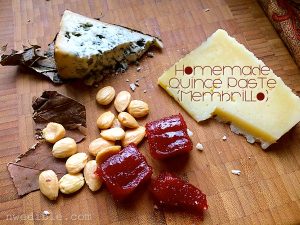
Erica, I’m so glad I found your blog. I feel that you food philosophy and mine are very, very similar. It’s always great to find kindred spirits.
I live in an area of the country where IF I could find quince available at all it would likely be considered so exotic that it would be priced too high to be affordable to make quince paste from scratch. I’ll just continue to purchase my membrillo already tinned. However, for those of you folks who are able to buy quince, don’t you think a batch of membrillo would work out perfectly in a slow cooker? That’s how I make my apple butter and my ketchup. It is perfect every time and with much less “stand & stir” time.
If you’re making a large batch (we typically turn about half of our quince harvest into membrillo) you should also take all the cores and peels and use them to make pectin. We get more than enough pectin to last the year from the trimmings off of bushel of quince.
I discovered a huge quince tree on public land behind my new home this year and went quince crazy (once I figured out what they were). I didn’t try to make membrillo, but I made some really great spiced quince that I served with the turkey on Thanksgiving, quince/apple sauce my kids adore, chai-spiced quince, and a couple random desserts. Quince are a bit tough to work with, but quite versatile. If anyone lives near the San Francisco East Bay area, I’ll have many more than I can use next year too!
What a great idea and post. I don’t know about any quince trees in Monterey County, California but now going to keep my eyes open and ask around. Who knows if I see a quince bare root tree I might be able to ask the H to plant it for me. I love a lovely cheeseboard and this quince paste would make it so special!
See Linda Ziedrich’s jam cookbook for a recipe for quince syrup, basically small quince pieces covered in honey, left for a few weeks. I use it as a winter cold recipe. My family hasn’t been laid up with a cold longer than overnight since we started using this several years ago. The honey supposedly has antibacterial qualities and the plentiful pectin in the quince has some medicinal qualities as well. A powerful placebo? I don’t care as long as it works.
We have a Russian quince tree that has terrible fungus problems so I lose most of what should be plentiful fruit. Any solutions anyone? We think the problem is a combination of the recent very rainy PNW springs and plentiful evergreens close by.
I have never heard of quince paste – but something that changes from yellow to red when cooked seems like a really fun project for kiddos…
I’ve thought about making this, but didn’t get around to it this year (well last year I guess.) Where did you buy your quince? I see persimmons at my grocery stores (and those can apparently be made into a similar paste,) but I never see quince.
I haven’t been able to find quince in Colorado at all, but my Mom found them in a Mexican grocery in California and brought some to me last year. We made the membrillo and ate it with manchego and it was amazing! I need to see if I can get her to visit to bring me more!
Considering manchego is my favorite cheese, I think I need to make this recipe. It reminds me of pate de fruit. I have a huge crop of strawberries every year that I turn into jam and pate. Anyone else make pate de fruit?
I love quince paste! This year I canned it in small jars to make sharing easier. I have also found that if I roast the quince in a covered pan until soft, and then run through a food mill I am able to avoid peeling and cutting through the tough fruit.
I am so glad I found this blog, it is right in my wheelhouse!
I’ve seen recipes for quince paste but not for how to can it. How is it done?
I’ve never had anything like this? Do you actually spread it on the cheese?
Little smear of paste on a cracker, top with cheese – you’re in business!
I love-love-love quince!
I love quince-squash soup! I keep peeled chunks of quince and peeled chunks of butternut squash in bags in the freezer so that I can make the soup whenever I want.
I love quince paste! We are fortunate to have easy access to Fanny Berg’s homemade dulce de membrillo, so we have it year-round. Mmmmmm. In fact, I am eating some right now with cheese and pita chips.
Also, we purchased two quince trees from Raintree Nursery in Washington as part of a wedding gift for our daughter and son-in-law in New England, where the quince tree was once as common as apple. There are dozens of types of quince, including the popular pineapple quince, which is grown for mass production. We picked out less common varieties that are known to be compatible with their environment, naturally disease resistant, very sweet, and easy to work with. They are shipped looking like bare twigs, but fill out quickly once planted.
Erica, the quince fruit that you purchased look excellent. It’s normal for there to be brown spots. Did you know that, while most people do peel quince before cooking, you don’t have to? You can chop and cook them, then put them through a sieve, which removes the peels later on. If you do peel first, use a potato peeler, not a typical vegetable peeler. It’ll save your wrists.
One more thing: Barbara Ghazarian has written an excellent book called Simply Quince, full of history, facts, and great quince recipes.
Thanks for this wonderfully inspiring post! (She says through a mouthful of dulce de membrillo!)
Yum!!! I like quince with lamb, like in a stew. I’ll check out the book you recommend – sounds great.
Thanks for this recipe. I love quince paste, when I lived in Australia I was addicted to Maggie Beers version of it and have missed it terribly. Little did I know it was something I could make. Looks like I have my weekend project all lined up, now all I have to do is find some actual quinces for sale, oh and get a nice cheese or 2 to go with it.
By the way, I thought it was interesting that the quince turns from yellow to red. Turns out that heat causes the tannins naturally in the quince to release anthocyanin, the red pigment. Here’s a good reference [http://www.finecooking.com/item/34720/quince]
And in another aside, I like what Sanj says about not peeling it first. I would just quarter the quinces and run everything through the food mill before weighing. Not that I’ve tried that method, or yours yet, but with the high pectin levels, I think it would be nice to get a firm set naturally. I’ll let you know how it goes!
Cool, thanks for the science!
The Bergs have a large quince orchard in Alvadore (Lane County, Oregon): http://www.registerguard.com/rg/business/30641330-63/quince-berg-paste-fruit-bergs.html.csp
I think I will add a couple or more quince to my orchard plans. I go crazy for guava paste when I can find it, and quince paste may be a good substitute for that.
I had never tasted anything made from quince until I made membrillo a couple of years ago, from excess quince that someone was freecycling from a tree in their yard 🙂 It was delicious – fantastic with Manchego. I successfully canned it as a paste/jam and it’s wonderful to have on hand.
“Marmelada” in Portugal! We use peel and core to do what we call “geleia”. Peel and core are boiled with sugar until you get the pearl point. Recently I have been doing pectin with peel and cores. Here in Portugal we eat marmelada/membrillo with sheep’s cheese, at the restaurant you ask for a Romeo and Juliet, a slice of marmelada with a slice of queijo da Serra. 🙂
Wonderful things…quinces. Sometimes I buy them just to place them in bowls around the house for the fragrance. And then, I get to cook them! Kevin West wrote a marvelous preserving book called “Saving the Season” that has several great recipes for quince: Nostradamus’ quince jelly (made with rose geranium leaves) , membrillo (made from the goodies leftover from the jelly prep) and Pliny’s quince in honey. T
And really, try the thing with rose geranium leaves…..I’ve been adding them to my raspberry jams for more than thirty years for that little extra something.
Me acabo de comprar un ordenador muy economico
I was just visiting my neighbor & she was bemoaning her weird, useless pear tree. They were awful pears because they’re actually amazing pineapple quince. I now have many pounds of fruit…now I just need to invest in many pounds of sugar so I can make your recipe. Thanks my friend! 🙂